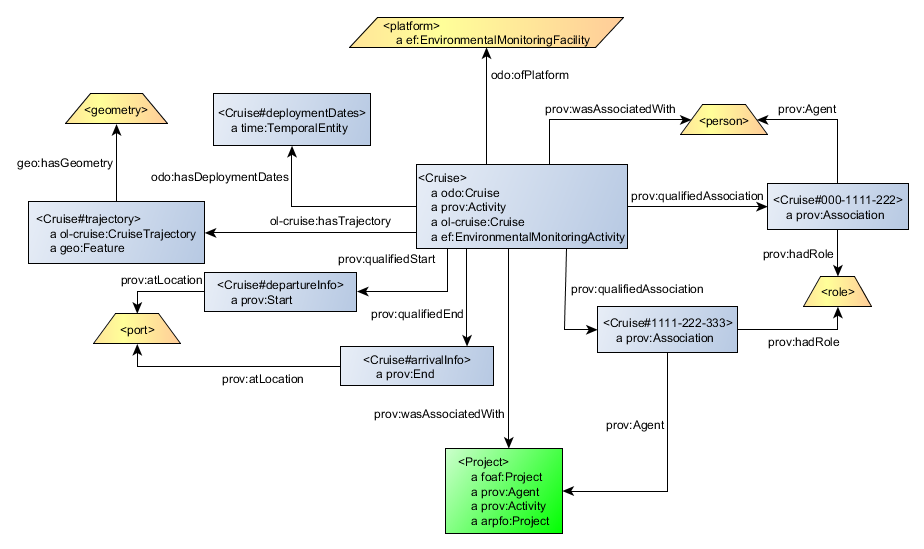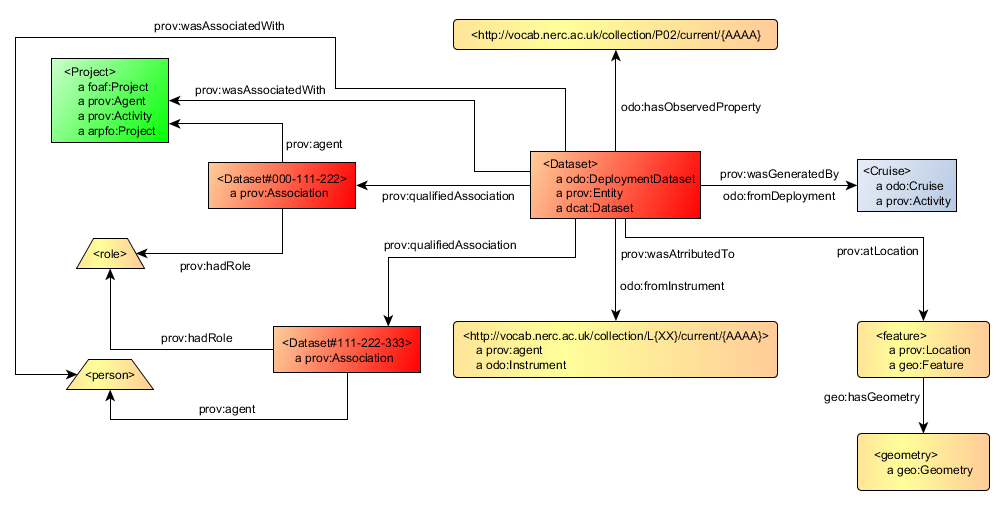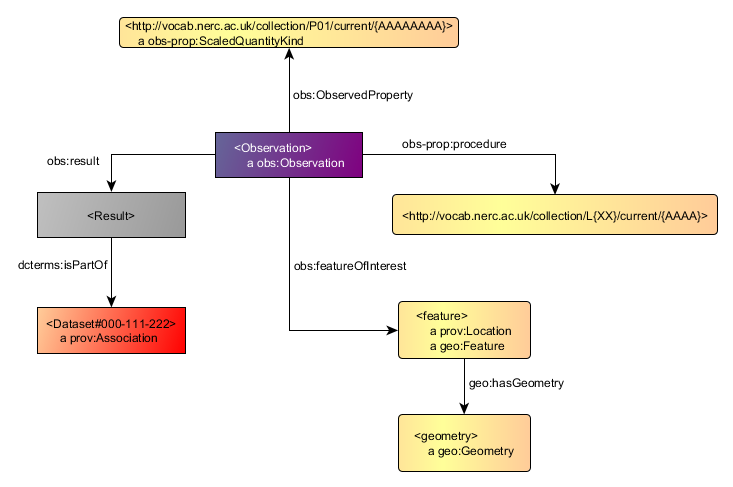This document shows the results from the Semantics Smackdown held at Rensselaer Polytechnic Institute, June 2014 as part of the Ocean Data Interoperability Platform project. During the final two days of this workshop, an approach to linking data using a generic pattern was discussed. This was driven by the use cases of interoperability between data repositories in the ocean sciences domain and also between ocean sciences data repositories and those from other domains. Therefore, the approach taken to modelling Linked Ocean Data was to use high level terms from ontologies and vocabularies which are well understood in a range of communities (for example PROV and Observations and Measurements, O&M) while maintaining the references to domain specific ontologies (such as the Ocean Data Ontology, ODO).
- Namespaces Used A list of the RDF namespaces used within this document
- Cruise The Linked Data pattern decided upon to describe a research cruise
- Dataset The Linked Data pattern decided upon to describe a dataset
- Geometry Example encoding of a GeoSPARQL geometry for the Linked Ocean Data patterns
- Observation The Linked Data pattern decided upon to link an Observations and Measurements observation to a dataset
- Project The Linked Data pattern decided upon to describe a project
- Temporal Entity Example encoding of an OWL Time temporal entity for the Linked Ocean Data patterns
- Workshop Participants A list of organisations represented at the workshop
- To-Do A list of remaining action items in the generation of this document
- Files A description of the file set presented within the GitHub repository
- arpfo http://vocab.ox.ac.uk/projectfunding#
- dcat http://www.w3.org/ns/dcat#
- dcterms http://www.purl.org/dc/terms/
- ef http://eidc.ceh.ac.uk/onto/ef#
- foaf http://xmlns.com/foaf/0.1/
- geo http://www.opengis.net/ont/geosparql#
- obs http://def.seegrid.csiro.au/isotc211/iso19156/2011/observation#
- obs-prop http://environment.data.gov.au/def/op#
- odo http://ocean-data.org/schema/
- ol-cruise http://schema.oceanlink.org/cruise#
- prov http://www.w3.org/ns/prov#
- rdf http://www.w3.org/1999/02/22-rdf-syntax-ns#
- sf http://www.opengis.net/ont/sf#
- time http://www.w3.org/2006/time#
A cruise is a discrete deployment of a platform (normally a research vessel) which has a trajectory from a port to another, or returning to the port of departure. The cruise itself is not a geographic feature, its trajectory is, therefore an intermediate resource for the trajectory must be instantiated to which the geometry can be assigned. The linkage is made using classes and properties from the OceanLink ontology. For the European partners within the Ocean Data Interoperability Platform, a cruise has been declared as an Environmental Monitoring Activity, and a platform as an Environmental Monitoring Facility. This allows for compatibility with the Environmental Monitoring Facilities (EF) theme of the European Commission's INSPIRE spatial data directive.
During the workshop, dataset entities were deemed to have been generated by cruise activities. However, there are use cases in operational modes (such as in SAMOS) where the cruise (a single port-to-port deployment of a platform, such as a research vessel) is not known. In this case we recommend that a PROV activity is created for a given calendar day's activity on that platform instead of a full cruise instance. This day's activity may later be mapped to a, for example, R2R cruise instance.
The use of prov:wasAttributedTo and odo:fromInstrument to link a dataset to the collecting instrument is optional, is repeatable (i.e. it is a one-to-many relationship) and no rank or instrument order should be inferred from the use of these properties. Similarly, the use of odo:hasObservedProperty to state the discovery level descriptions of the observed properties within a dataset is both optional and repeatable.
AS per the guidance for best practice which emerged from the joint World Wide Web Consortium/Open Geospatial Consortium Linking Geospatial Data workshop, geometries are given their own URIs so they may be reused, and are not part of the metadata for their feature. For a cruise, the cruise has a trajectory which is the feature and the track of that trajectory is the geometry.
@prefix olc: <http://schema.oceanlink.org/pattern-name>.
@prefix geo: <http://www.opengis.net/ont/geosparql#>.
@prefix sf: <http://www.opengis.net/ont/sf#>.
<http://foo.bar/cruise> a olc:cruise;
olc:hasTrajectory <http://foo.bar/cruise_trajectory>.
<http://foo.bar/cruise_trajectory> a olc:Trajectory;
a geo:Feature;
geo:hasGeometry <http://foo.bar/cruise_geometry>.
<http://foo.bar/cruise_geometry> a sf:LineString;
geo:asWKT "<http://www.opengis.net/def/crs/OGC/1.3/CRS84> LINESTRING(-68.7030 37.934, -68.7160 37.92, -67.4650 36.019, -67.3680 35.865, -67.2700 35.715, -67.1720 35.558, -67.0770 35.408, -66.9780 35.257, -66.8880 35.108, -66.7850 34.952, -66.6950 34.802)"^^geo:wktliteral.
Observations are built from the O&M data model, and we can easily model the Observed Properties from the BODC Parameter Usage Vocabulary, procedure from the SeaVoX Device Catalogue and result from the relevant data file, which forms part of the dataset resource. Datasets are linked to Observations through both the Result and the Feature of Interest.
In order to encode temporal entities associated with cruise deployment dates and with project dates, we chose to implement the Temporal Entity objects from OWL Time. An example encoding of a Temporal Entity is shown below.
<http://linked.bodc.ac.uk/series/952050#time> a time:TemporalEntity ;
time:hasBeginning <http://linked.bodc.ac.uk/series/952050#timeBegins> ;
time:hasEnd <http://linked.bodc.ac.uk/series/952050#timeEnds> .
<http://linked.bodc.ac.uk/series/952050#timeBegins> a time:instance ;
time:inXSDDateTime "1994-10-31T03:00:00Z"^^xsd:datetime ;
time:inDateTime <http://linked.bodc.ac.uk/series/952050#timeBeginsDescription> .
<http://linked.bodc.ac.uk/series/952050#timeBeginsDescription> a time:DateTimeDescription ;
time:unitType time:unitSecond ;
time:second "00" ;
time:dayOfWeek time:Tuesday ;
time:minute "00" ;
time:hour "03" ;
time:day "18" ;
time:month "10" ;
time:year "1994" ;
time:dayOfYear "291" ;
time:timeZone <http://www.w3.org/2006/timezone-world#ZTZ> .
<http://linked.bodc.ac.uk/series/952050#timeEnds> a time:instance ;
time:inXSDDateTime "1994-10-31T11:02:00Z"^^xsd:datetime ;
time:inDateTime <http://linked.bodc.ac.uk/series/952050#timeEndsDescription> .
<http://linked.bodc.ac.uk/series/952050#timeEndsDescription> a time:DateTimeDescription ;
time:unitType time:unitSecond ;
time:second "00" ;
time:dayOfWeek time:Monday ;
time:minute "02" ;
time:hour "11" ;
time:day "31" ;
time:month "10" ;
time:year "1994" ;
time:dayOfYear "304" ;
time:timeZone <http://www.w3.org/2006/timezone-world#ZTZ> .
<http://linked.bodc.ac.uk/series/952050#timeBeginsDescription> a time:DateTimeDescription ;
time:timeZone <http://www.w3.org/2006/timezone-world#ZTZ> .
- Biological and Chemical Oceanography Data Management Office, Woods Hole
Oceanographic Institution, USA
- Cyndy Chandler
- Adam Shepherd
- British Oceanographic Data Centre, Natural Environment Research Council, UK
- Adam Leadbetter
- Rob Thomas
- Lamont-Doherty Earth Observatory, Columbia University, USA
- Bob Arko
- Tetherless World Constellation, Rensselaer Polytechnic Institute, USA
- Yanning Chen
- Peter Fox
- Linyun Fu
- Patrick West
- Stephan Zednik
- Scripps Institution of Oceanography, University of California San Diego, USA
- Renata Ferreira
- Shipboard Automated Meterological and Oceanographic System,
Florida State University, USA
- Nkem Dockery
data-model.ttl A Turtle file containing an abstract data model for Linked Ocean Data created during the meeting.
overview.graphml A GraphML file showing the high level overview of the Linked Ocean Data data model
overview.png A PNG file showing the high level overview of the Linked Ocean Data data model
/cruise A file folder for the Linked Data pattern describing a cruise.
/dataset A file folder for the Linked Data pattern describing a project.
/observation A file folder for the Linked Data pattern describing an observation.
/project A file folder for the Linked Data pattern describing a project.




